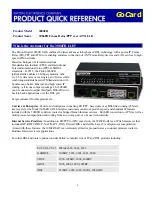
XS26GS Managed Optical Ethernet Switch User Manual
170
Parameters
source
: set uplink ports that receive and send multicast data as source ports.
receiver
: set a port as a receiver port if it is a subscriber port and should only receive
multicast data. It does not receive data unless it becomes a member of the
multicast group, either statically or by using IGMP leave and join messages.
none:
remove the
source
or
receiver
port from the multicast VLAN.
ethernet-port:
ethernet port, in the form of
interface
=
{
interface-type
/
interface-number
},
interface-type
= {0 | 1}, when
interface-type
is 0,
interface-number
= { 1 | 2 | … | 24 }, when
interface-type
is 1,
interface-number
= { 1 | 2 }.
Description
Use
mvr port type
to configure a source or receiver port for multicast VLAN or
remove them from the multicast VLAN.
Examples
XS# mvr port type receiver ethernet 0/3 to ethernet 0/5
The configuration is successful.
mvr mode
Syntax
mvr
mode
{dynamic| compatible}
View
System view
Parameters
compatible
mode: multicast data received by MVR hosts is forwarded to all MVR
data ports, regardless of MVR host membership on those ports. The multicast data
is forwarded only to those receiver ports that MVR hosts have joined, either by IGMP
reports or by MVR static configuration. IGMP reports received from MVR hosts are
never forwarded from MVR data ports that were configured in the switch.
dynamic
mode: multicast data received by MVR hosts on the switch is forwarded
from only those MVR data and client ports that the MVR hosts have joined, either by
IGMP reports or by MVR static configuration. Any IGMP reports received from MVR
hosts are also forwarded from all the MVR data ports in the switch. This eliminates
the use of unnecessary bandwidth on MVR data port links, which occurs when the
switch runs in compatible mode.
Description
Use
mvr mode
to
specify a mode for the mvr.
The default mode is dynamic.
Examples
XS# mvr mode dynamic
mode of mvr set to dynamic
mvr mVlan















































